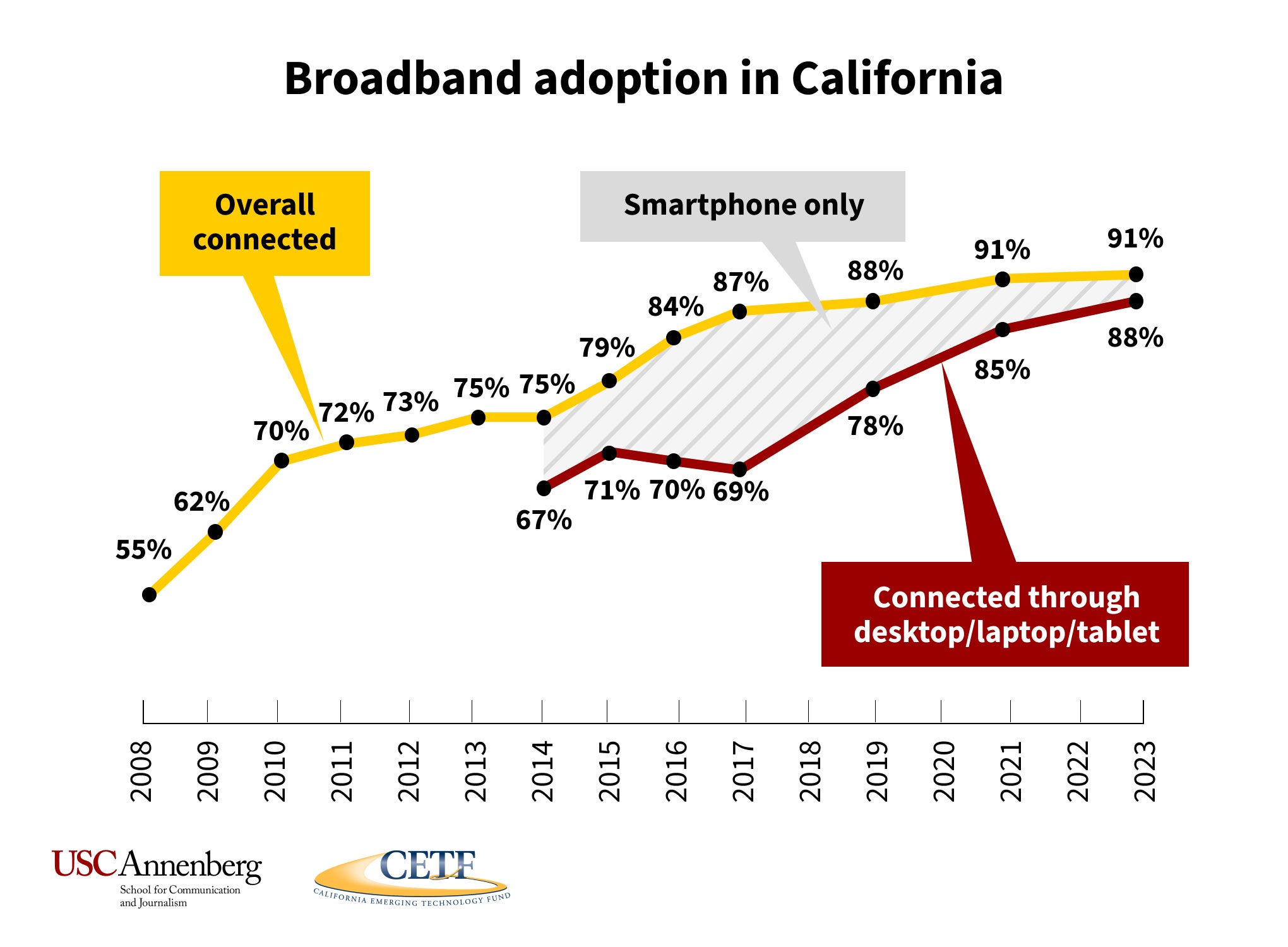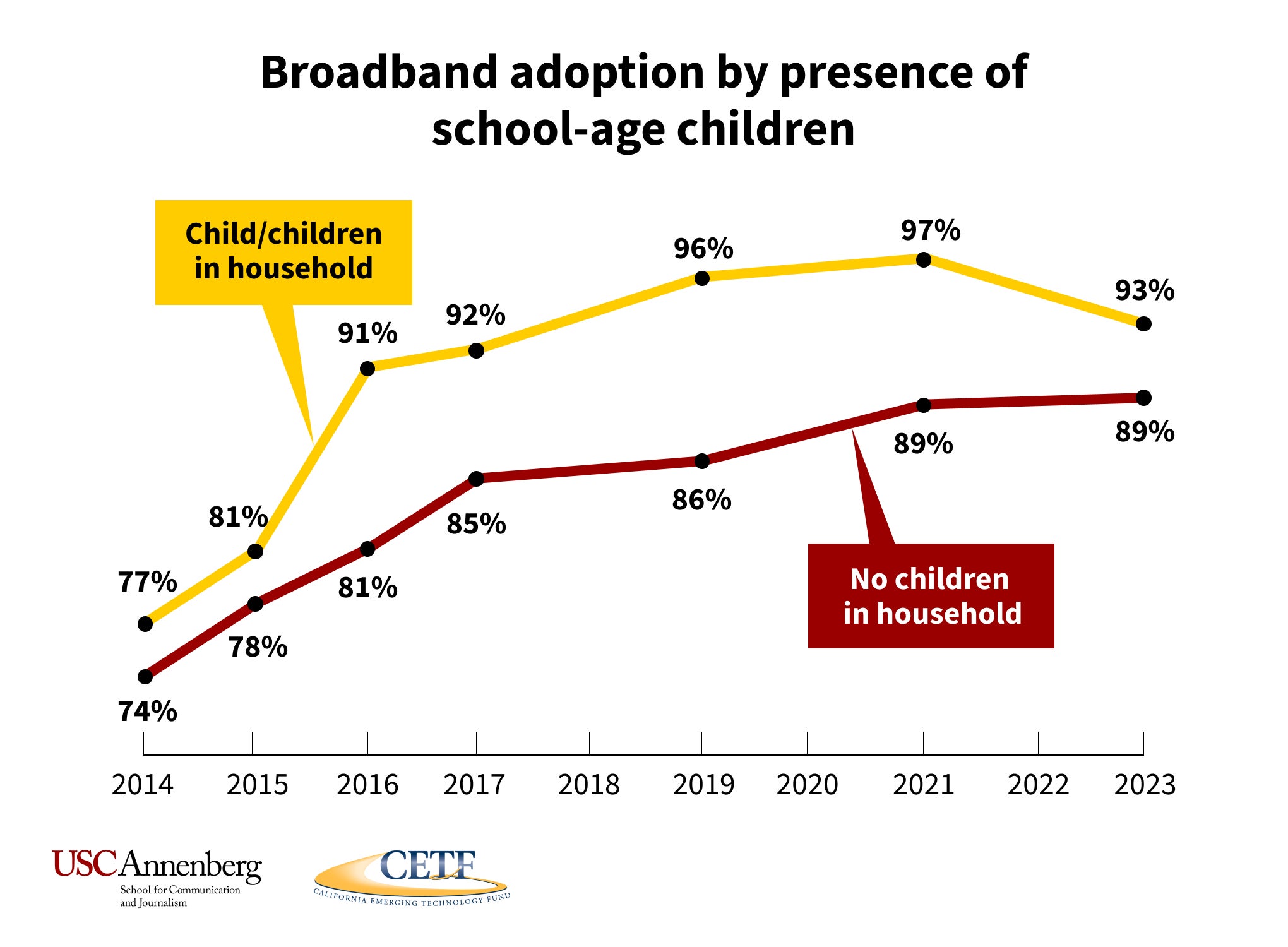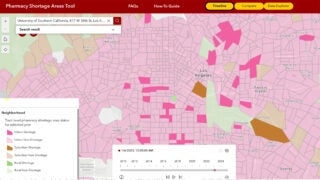
(Photo/iStock)
‘Digital divide’ narrowing in California, but many low-income residents remain underconnected
A survey by USC researchers and the California Emerging Technology Fund indicates that 91% of state households have broadband, yet challenges persist for low-income K-12 families.
Statewide broadband adoption remains high with 91% of households in California enjoying high-speed internet access at home, according to new survey results released Monday by USC, the California Emerging Technology Fund and the California Department of Technology.
The overall findings are consistent with the 2021 results of the biennial Statewide Digital Equity Survey, which monitors Californians’ digital access. The latest findings also reveal that the percentage of underconnected households — those with only a smartphone — was cut in half from 6% to 3%.

In addition, fewer children in K-12 households have a desktop, laptop or tablet computer available at home to use for school activities that are not shared with other family members, a decline from nearly 95% in 2021 to about 72% in 2023, the researchers found.
“There was significant progress in reducing the number of underconnected households,” said Hernán Galperin, the study’s lead researcher and a professor at the USC Annenberg School for Communication and Journalism. “However, our latest data also point to the sobering reality of the challenges in reaching the most digitally disadvantaged households.”
The 2023 survey is the largest endeavor to date by USC Annenberg researchers and the California Emerging Technology Fund in collaboration with California Department of Technology to obtain a highly representative sample of Californians.
“We went to great lengths developing a robust methodology to get the clearest picture of how Californians are faring in broadband adoption,” said Sunne Wright McPeak, president and CEO of the California Emerging Technology Fund. “We now know we still have some miles to go for Californians to achieve full adoption. The survey confirms that affordability remains the major barrier to broadband adoption and underscores the need to ensure that low-income households always will have affordable home internet service available to them.”

The researchers used a multimodal approach — an effective method for sampling hard-to-reach populations, including unconnected and underconnected households — by combining text-to-online responses with telephone interviews conducted through random digit dialing.
In addition, researchers oversampled residents in rural counties and low-income households, as well as people with disabilities.
CETF has sponsored the Statewide Digital Equity Survey since 2008. USC has been the independent research partner for conducting the California Emerging Technology Fund surveys in 2021 and 2023.
‘Digital divide’: More Californians come online
The results show that California has made significant progress in improving internet access among specific disadvantaged groups, such as:
- Households with disabilities, up from 83% in 2021 to 91% in 2023.
- Adults 60 years and older, increasing from 78% in 2021 to 90% in 2023.
- Adults without a high-school degree, up from 64% in 2021 to 79% in 2023.
The data also show that overall adoption trends among racial minority groups improved over the past decade. Among Asian Americans, broadband adoption levels have reached similar levels as those among non-Hispanic white residents. Hispanic/Latino residents still trail non-Hispanic white residents by about 10 percentage points; however, the most recent data show progress in broadband adoption after several years of declines, the researchers wrote.
“To truly eliminate the digital divide, we must confront racial/ethnic disparities by implementing targeted strategies and policies that uplift digitally disadvantaged communities,” said François Bar, co-author of the study and professor of communication and spatial sciences at USC Annenberg. “The insights gleaned from this latest survey can help shape these initiatives.”
About the survey: The Statewide Survey on Broadband Adoption has been conducted regularly since 2008.
Methodology: The 2023 Statewide Survey on Broadband Adoption and Digital Equity is one of the largest ever conducted on broadband adoption in California. The performance standards for the survey methodology were established by the California Department of Technology in collaboration with the California Emerging Technology Fund. The methodology included telephone interviews conducted through random digit dialing and text-to-online responses, as well as an oversample of pre-paid numbers to capture low-income households. People with disabilities were contacted based on a California Department of Rehabilitation randomized client list. Overall, the sample included 3,560 households, including 1,899 in the main sample. Another 1,661 households were part of a targeted oversample comprising 1,059 rural California households, 283 low-income households, and 319 people with disabilities. The overall margin of error for the survey was plus or minus 3%.
Featured Experts
Francois Bar
Expert in economic policy, Net neutrality, comparative telecommunications, social and strategic dimensions of the Internet, information technology and international development, technology management, wi-fi and wireless technologies and political economy of information
Hernan Galperin
Expert in Digital divide, Internet policy, Telecommunications in Latin America, Internet and development, Gig economy, Digital labor and Net neutrality



